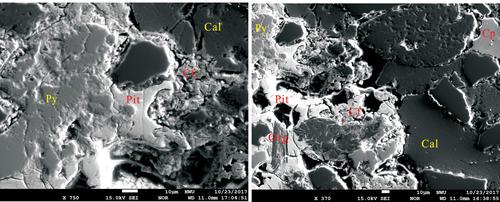当前位置:
X-MOL 学术
›
Acta Geol. Sinica Engl. Ed.
›
论文详情
Our official English website, www.x-mol.net, welcomes your
feedback! (Note: you will need to create a separate account there.)
Characteristics of Uranium Mineralization in Red Clastic Formations in the Southwestern Margin of the Ordos Basin
Acta Geologica Sinica-English Edition ( IF 3.5 ) Pub Date : 2020-02-13 , DOI: 10.1111/1755-6724.14500 Zilong ZHANG 1 , Feng HE 1 , Longsheng YI 1 , Honghai FAN 1 , Yuqi CAI 1 , Hongxu LIU 1 , Xinyang LIU 2 , Hongbin CHEN 3 , Cui JIA 1 , Mengjia YANG 1
Acta Geologica Sinica-English Edition ( IF 3.5 ) Pub Date : 2020-02-13 , DOI: 10.1111/1755-6724.14500 Zilong ZHANG 1 , Feng HE 1 , Longsheng YI 1 , Honghai FAN 1 , Yuqi CAI 1 , Hongxu LIU 1 , Xinyang LIU 2 , Hongbin CHEN 3 , Cui JIA 1 , Mengjia YANG 1
Affiliation

|
In the southwestern margin of the Ordos Basin, uranium mineralization is primarily hosted by predominantly oxidative red clastic formations in the Lower Cretaceous. The main target layers for uranium exploration are the Madongshan and Liwaxia formations of the Liupanshan Group, followed by the Jingchuan Formation of the Zhidan Group. The host rocks (medium‐fine feldspar quartz sandstone), which are bleached to a light grayish white color, contain a minor organic matter component and pyrite. Uranium mineralization changes from surficial infiltration or phreatic oxidation in the upper part to interlayer oxidation in the lower part. Uranium ore bodies are mostly lenticular or tabular in shape, locally shaped like crescent rolls. Individual ore bodies are typically small and shallow. Uranium predominantly manifests as pitchblende and coffinite. Coffinite is usually short and columnar or granular in habit, whereas pitchblende occurs as an irregular colloidal covering on the surface or in fissures of ferric oxide, silicate, clay or carbonate. Secondary uranium minerals are torbernite, uranophane, and uranopilite. Minerals associated with uranium are mainly pyrite, chalcopyrite and, to a minor extent, arsenopyrite and fluorite. The associated elements are Mo, V, Se, Co, Ni, and Mn, the host sandstone being high in Cu and Ba. Overall, the red clastic formations in the southwestern margin of the Ordos Basin are characterized by ‘five multiples but one low’ which means multiple target layers, multiple stages of mineralization, multiple ore body shapes, multiple kinds of uranium minerals, multiple associated elements, but low organic matter. This implies an overall complex uranium metallogenic environment and mineralization process. It is recommended that future uranium exploration should take into consideration regional metallogenic conditions and mineralization features, with target layers in the wide‐smooth synclinal slope being focused on. Most uranium deposits are small to medium in size, and the main type of uranium mineralization can vary by target layer.
中文翻译:

鄂尔多斯盆地西南缘红色碎屑岩铀矿化特征
在鄂尔多斯盆地的西南边缘,铀矿化主要由下白垩统的氧化性红碎屑岩为主。铀勘探的主要目标层是六盘山组的马东山组和利瓦夏组,其次是志丹组的井川组。被漂白成浅灰白色的主体岩石(中细长石石英砂岩)含有少量有机物成分和黄铁矿。铀的矿化作用从上部的表层渗透或潜水氧化转变为下部的层间氧化。铀矿体的形状大多为柱状或板状,局部形状像月牙形。单个矿体通常较小而浅。铀主要表现为沥青和钴氧化物。Coffinite通常很短,有柱状或粒状的习性,而混合闪锌矿则是在表面上或氧化铁,硅酸盐,粘土或碳酸盐的裂缝中形成不规则的胶体覆盖物。次要铀矿物质是菱锰矿,铀铀矿和铀锰矿。与铀有关的矿物主要是黄铁矿,黄铜矿,以及少量的毒砂和萤石。相关元素是Mo,V,Se,Co,Ni和Mn,主体砂岩中的Cu和Ba高。总体而言,鄂尔多斯盆地西南缘的红色碎屑岩特征是“五个多但一个低”,这意味着多个目标层,多个矿化阶段,多个矿体形态,多种铀矿,多种相关元素,但有机物含量低。这意味着铀矿成矿环境和矿化过程总体复杂。建议未来的铀勘探应考虑区域成矿条件和成矿特征,并重点关注宽滑向斜斜坡中的目标层。大多数铀矿床大小不一,中等大小,铀矿化的主要类型因目标层而异。
更新日期:2020-02-13
中文翻译:

鄂尔多斯盆地西南缘红色碎屑岩铀矿化特征
在鄂尔多斯盆地的西南边缘,铀矿化主要由下白垩统的氧化性红碎屑岩为主。铀勘探的主要目标层是六盘山组的马东山组和利瓦夏组,其次是志丹组的井川组。被漂白成浅灰白色的主体岩石(中细长石石英砂岩)含有少量有机物成分和黄铁矿。铀的矿化作用从上部的表层渗透或潜水氧化转变为下部的层间氧化。铀矿体的形状大多为柱状或板状,局部形状像月牙形。单个矿体通常较小而浅。铀主要表现为沥青和钴氧化物。Coffinite通常很短,有柱状或粒状的习性,而混合闪锌矿则是在表面上或氧化铁,硅酸盐,粘土或碳酸盐的裂缝中形成不规则的胶体覆盖物。次要铀矿物质是菱锰矿,铀铀矿和铀锰矿。与铀有关的矿物主要是黄铁矿,黄铜矿,以及少量的毒砂和萤石。相关元素是Mo,V,Se,Co,Ni和Mn,主体砂岩中的Cu和Ba高。总体而言,鄂尔多斯盆地西南缘的红色碎屑岩特征是“五个多但一个低”,这意味着多个目标层,多个矿化阶段,多个矿体形态,多种铀矿,多种相关元素,但有机物含量低。这意味着铀矿成矿环境和矿化过程总体复杂。建议未来的铀勘探应考虑区域成矿条件和成矿特征,并重点关注宽滑向斜斜坡中的目标层。大多数铀矿床大小不一,中等大小,铀矿化的主要类型因目标层而异。











































 京公网安备 11010802027423号
京公网安备 11010802027423号